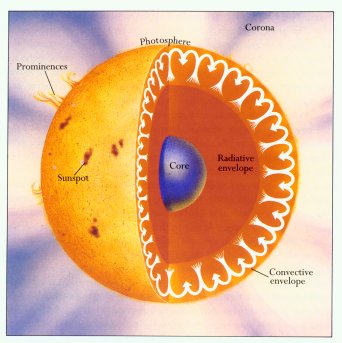
| EVOLUTION | ACTIVITY | PROPERTIES | OTHER SUNS |
 |
A model of the Sun shows its nuclear fusing core (where hydrogen is turned into helium, resulting in the conversion of mass into energy), an envelope that extends 71 percent of the way out, where energy is transferred by radiation, and an outer layer where convection (the rising of hot gases, falling of cool gases) rules. At the surface (the photosphere, where the bulk of the solar spectrum is formed), rising magnetic fields locally cool the solar gases to make sunspots. Surrounding the whole affair is the magnetically heated solar corona, which is confined by great magnetic loops. At a typical temperature of two million degrees Kelvin, the corona is the seat of the solar wind. Prominences are threads of cool gas that lie in the corona and are supported by magnetic fields. Not shown, between the corona and photosphere is the thin reddish chromosphere. (From Stars, J. B. Kaler, Scientific American Library, Freeman, NY, 1992, copyright © J. B. Kaler.) |
| Property | Physical Units | Relative to Earth/Remarks |
| Mean distance | 149,597,871 km | 1 AU; 389 X distance to Moon |
| Diameter | 1.391 X 10**6 km | 109.1 (equatorial) |
| Mass | 1.989 X 10**33 grams | 3.329 X 10**5 |
| Non-core composition | 91.5% H, 8.5% He, 0.15% other | Nearly 100% "other" |
| Average density | 1.407 gm/cubic cm | 0.2551 |
| Surface gravity | 2.740 X 10**4 cm/sec**2 | 27.94 |
| Escape velocity | 617.7 km/s | 55.2 |
| Polar magnetic field | ... | A few times |
| Age | 4.6 billion years | 1.00 |
| Luminosity | 3.845 X 10**26 watts | 1367 watts/square meter at Earth |
| Spectral class | G2 V | ... |
| Apparent visual magnitude | -26.75 | 420,000 times that of full Moon |
| Absolute visual magnitude | 4.83 | ... |
| Color index (B-V) | 0.65 | ... |
| Color index (U-B) | 0.19 | ... |
| Bolometric correction | -0.08 magnitudes | Visual-to-total magnitude |
| Effective temperature | 5777 Kelvin | 23 |
| Equatorial rotation period | 25.1 days | 27.1 days rel. to Earth |
| Depth of convection zone | 0.29 solar radius | ... |
| Main oscillation period | 5 minutes | ... |
| Central temperature | 15.7 million Kelvin | 2200 |
| Central density | 162 gm/cubic centimeter | 12; 14.3 X lead |
| Central pressure | 2.5 X 10**11 Earth atmospheres | ... |
| Solar wind rate | 5 X 10**-14 Msun/yr | Speed at Earth, 200-700 km/s |
| Sunspot cycle | 11 years | ... |
| Coronal temperature | 2 million Kelvin | ... |
| Star | Class | Vis mag | Dist (pc) | Abs mag | Temp (K) | Lum (Suns) | Mass (Suns) | Rotation (days) | Age/Remarks |
| Sun | G2 V | -26.75 | ... | 4.83 | 5777 | 1.00 | 1.00 | 25.1 | ... |
| 53 Aqr A | G1 V | 6.35 | 20 | 4.75 | 5830 K | 1.07 | 1.0 | <5.4 | ... |
| 53 Aqr B | G2 V | 6.57 | 20 | 4.85 | 5790 | 0.99 | 1.0 | <6.3 | Binary mass 2.25 Msun |
| Alpha Cen A | G2 V | -0.01 | 1.3 | 4.34 | 5780 | 1.57 | 1.10 | 25 | Except for Proxima, nearest star |
| 9 Cet | G2 V | 6.39 | 20.9 | 4.79 | 5760 | 1.04 | 1.0 | 7.8 | 5.5 Gyr, metal-rich |
| Rho CrB | G2 V | 5.41 | 17.2 | 4.16 | 5822 | 1.72 | 1.0 | ... | 10 Gyr; planet |
| 16 Cyg A | G1.5 V | 5.96 | 21 | 4.33 | 5750 | 1.58 | 1.0 | <32 | 8 Gyr |
| 16 Cyg B | G2.5 V | 6.20 | 21 | 4.57 | 5770 K | 1.27 | 1.01 | <19 | Planet |
| 18 Sco | G2 V | 5.50 | 13.9 | 4.78 | 5789 | 1.05 | 1.01 | 23 | Mag cycle 9-13 yr |
| Zeta-2 Ret | G2 V | 5.24 | 12.1 | 4.84 | 5795 | 0.98 | 0.96 | ... | Zeta-1 G3-5, mass 0.9 |